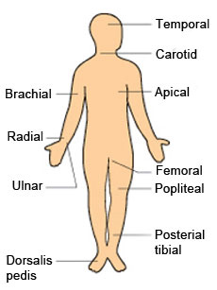
The pulse that you will learn to take is the radial pulse. To find a radial pulse:
Take a pulse in the following situations:
When you take a pulse – you should be able to easily feel the pulse wave push against your fingers in an even, regular pattern, without any missed beats. It feels like a tap against your fingertips.
Some people with heart disease have surgery to place special devices under the skin in the chest. These devices keep the heart rate and rhythm regular and within the normal range of beats per minute. These devices are called a pacemaker and an implantable cardioverter-defibrillator (ICD).
A pacemaker’s wires pass through a large vein into a chamber of the heart. The pacemaker sends out mild electrical pulses that keep the heart from beating too slow. A doctor will prescribe the minimum rate that the pacemaker is set.
An implantable cardioverter-defibrillator (ICD) is placed under a person’s skin, usually below the left collarbone. A wire threaded through a large vein connects the device to the heart. An ICD is always checking the person’s heart rate. If the heart starts beating dangerously fast, the ICD sends a strong electrical shock to the heart to return it to a normal rhythm. If the heart is beating too slow, the ICD acts as a pacemaker, sending mild electrical pulses to make the heart beat at a faster rate. The doctor will give guidelines for having each of these devices checked on a regular basis.